Effective Human Resource Management: A Literature Review Analysis
VerifiedAdded on 2021/05/30
|11
|2153
|27
Literature Review
AI Summary
This literature review delves into the critical aspects of human resource management (HRM) within organizations, focusing on strategies to enhance worker retention and productivity. It explores emerging issues such as workplace diversity, leadership styles, and their impacts on employee motivation and commitment. The review synthesizes findings from various scholarly articles, including those by Beltrán-Martín and Bou-Llusar (2018), Cox and Blake (2011), and Knippenberg (2009), highlighting the significance of team building, effective communication, and leadership approaches in fostering a positive work environment. The literature emphasizes the importance of addressing cultural and language barriers, promoting knowledge sharing, and creating a sense of belonging among employees. The review also examines the relationship between employee motivation and retention, suggesting that timely rewards, employee empowerment, and efficient leadership are crucial for organizational success. Ultimately, the review offers insights and recommendations for organizations like the Wildlife Rescue and Care organization to improve employee retention and overall performance.
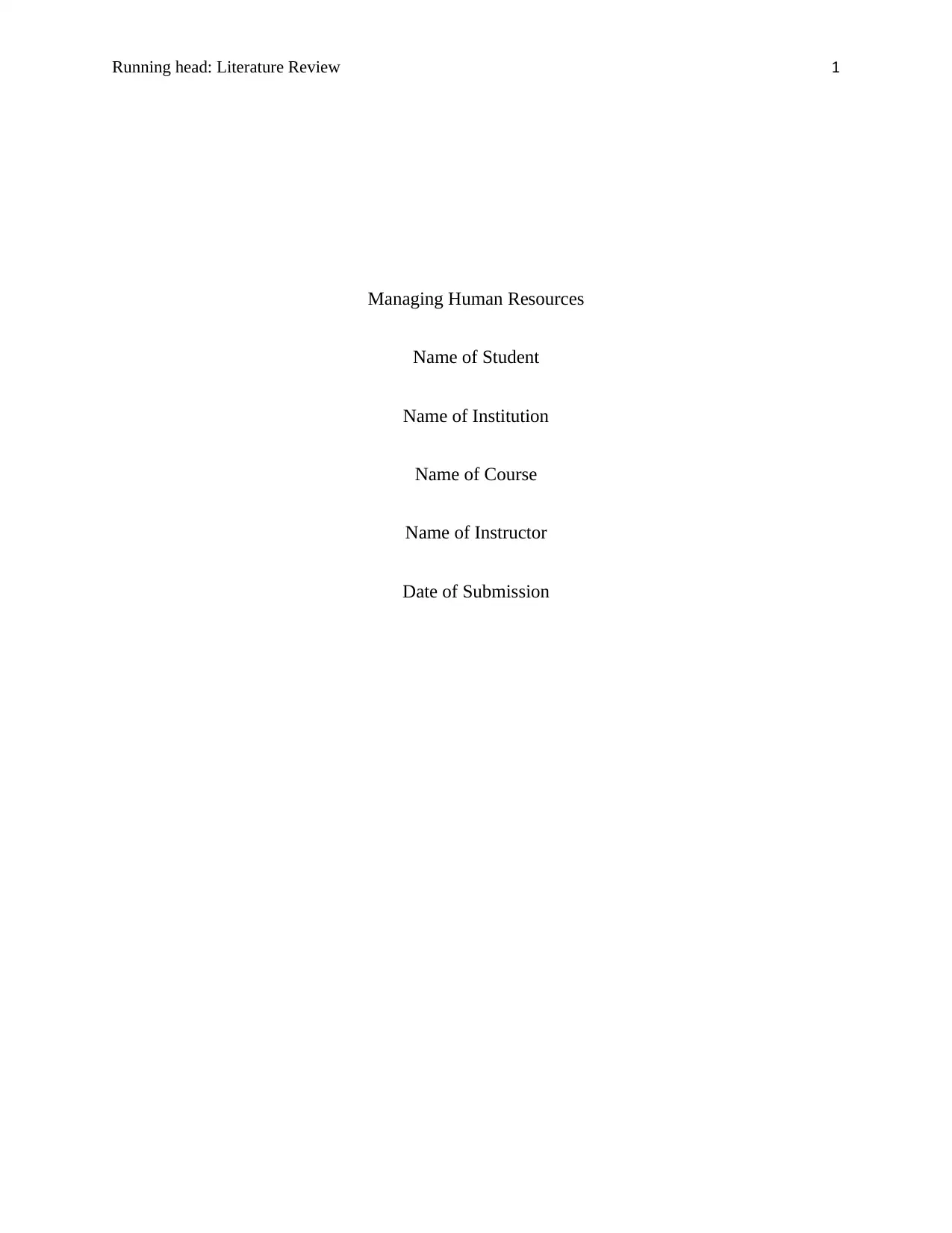
Running head: Literature Review 1
Managing Human Resources
Name of Student
Name of Institution
Name of Course
Name of Instructor
Date of Submission
Managing Human Resources
Name of Student
Name of Institution
Name of Course
Name of Instructor
Date of Submission
Paraphrase This Document
Need a fresh take? Get an instant paraphrase of this document with our AI Paraphraser
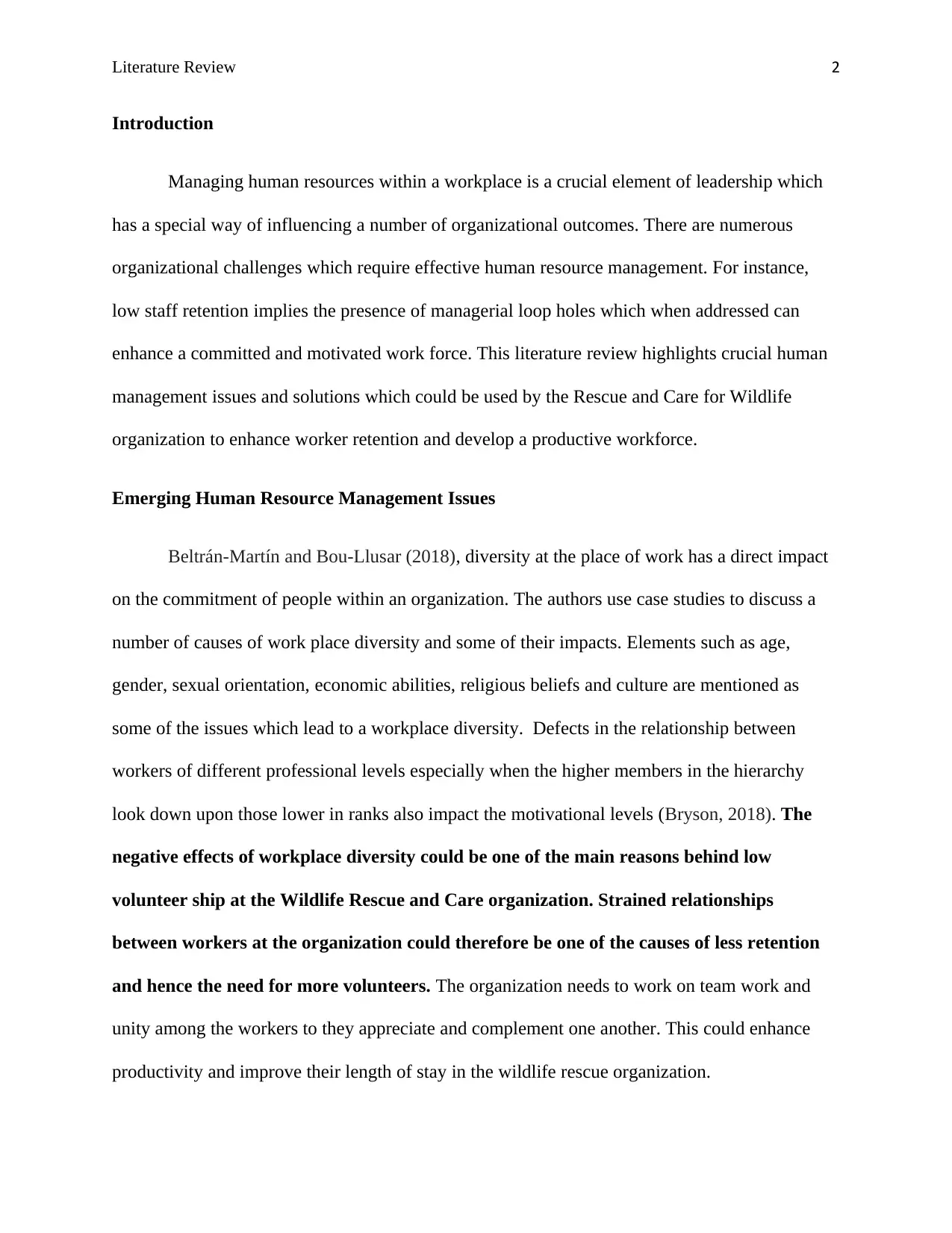
Literature Review 2
Introduction
Managing human resources within a workplace is a crucial element of leadership which
has a special way of influencing a number of organizational outcomes. There are numerous
organizational challenges which require effective human resource management. For instance,
low staff retention implies the presence of managerial loop holes which when addressed can
enhance a committed and motivated work force. This literature review highlights crucial human
management issues and solutions which could be used by the Rescue and Care for Wildlife
organization to enhance worker retention and develop a productive workforce.
Emerging Human Resource Management Issues
Beltrán-Martín and Bou-Llusar (2018), diversity at the place of work has a direct impact
on the commitment of people within an organization. The authors use case studies to discuss a
number of causes of work place diversity and some of their impacts. Elements such as age,
gender, sexual orientation, economic abilities, religious beliefs and culture are mentioned as
some of the issues which lead to a workplace diversity. Defects in the relationship between
workers of different professional levels especially when the higher members in the hierarchy
look down upon those lower in ranks also impact the motivational levels (Bryson, 2018). The
negative effects of workplace diversity could be one of the main reasons behind low
volunteer ship at the Wildlife Rescue and Care organization. Strained relationships
between workers at the organization could therefore be one of the causes of less retention
and hence the need for more volunteers. The organization needs to work on team work and
unity among the workers to they appreciate and complement one another. This could enhance
productivity and improve their length of stay in the wildlife rescue organization.
Introduction
Managing human resources within a workplace is a crucial element of leadership which
has a special way of influencing a number of organizational outcomes. There are numerous
organizational challenges which require effective human resource management. For instance,
low staff retention implies the presence of managerial loop holes which when addressed can
enhance a committed and motivated work force. This literature review highlights crucial human
management issues and solutions which could be used by the Rescue and Care for Wildlife
organization to enhance worker retention and develop a productive workforce.
Emerging Human Resource Management Issues
Beltrán-Martín and Bou-Llusar (2018), diversity at the place of work has a direct impact
on the commitment of people within an organization. The authors use case studies to discuss a
number of causes of work place diversity and some of their impacts. Elements such as age,
gender, sexual orientation, economic abilities, religious beliefs and culture are mentioned as
some of the issues which lead to a workplace diversity. Defects in the relationship between
workers of different professional levels especially when the higher members in the hierarchy
look down upon those lower in ranks also impact the motivational levels (Bryson, 2018). The
negative effects of workplace diversity could be one of the main reasons behind low
volunteer ship at the Wildlife Rescue and Care organization. Strained relationships
between workers at the organization could therefore be one of the causes of less retention
and hence the need for more volunteers. The organization needs to work on team work and
unity among the workers to they appreciate and complement one another. This could enhance
productivity and improve their length of stay in the wildlife rescue organization.
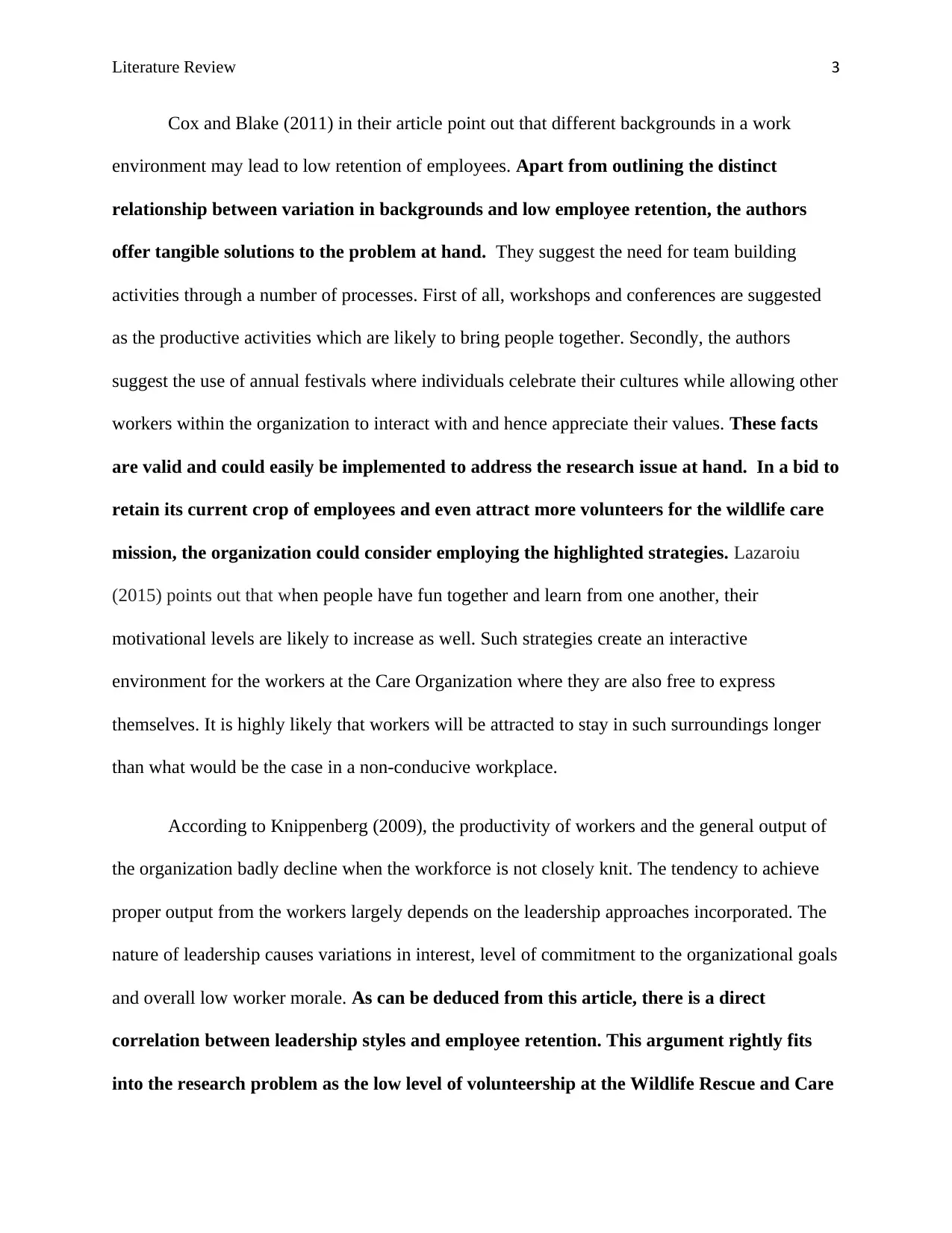
Literature Review 3
Cox and Blake (2011) in their article point out that different backgrounds in a work
environment may lead to low retention of employees. Apart from outlining the distinct
relationship between variation in backgrounds and low employee retention, the authors
offer tangible solutions to the problem at hand. They suggest the need for team building
activities through a number of processes. First of all, workshops and conferences are suggested
as the productive activities which are likely to bring people together. Secondly, the authors
suggest the use of annual festivals where individuals celebrate their cultures while allowing other
workers within the organization to interact with and hence appreciate their values. These facts
are valid and could easily be implemented to address the research issue at hand. In a bid to
retain its current crop of employees and even attract more volunteers for the wildlife care
mission, the organization could consider employing the highlighted strategies. Lazaroiu
(2015) points out that when people have fun together and learn from one another, their
motivational levels are likely to increase as well. Such strategies create an interactive
environment for the workers at the Care Organization where they are also free to express
themselves. It is highly likely that workers will be attracted to stay in such surroundings longer
than what would be the case in a non-conducive workplace.
According to Knippenberg (2009), the productivity of workers and the general output of
the organization badly decline when the workforce is not closely knit. The tendency to achieve
proper output from the workers largely depends on the leadership approaches incorporated. The
nature of leadership causes variations in interest, level of commitment to the organizational goals
and overall low worker morale. As can be deduced from this article, there is a direct
correlation between leadership styles and employee retention. This argument rightly fits
into the research problem as the low level of volunteership at the Wildlife Rescue and Care
Cox and Blake (2011) in their article point out that different backgrounds in a work
environment may lead to low retention of employees. Apart from outlining the distinct
relationship between variation in backgrounds and low employee retention, the authors
offer tangible solutions to the problem at hand. They suggest the need for team building
activities through a number of processes. First of all, workshops and conferences are suggested
as the productive activities which are likely to bring people together. Secondly, the authors
suggest the use of annual festivals where individuals celebrate their cultures while allowing other
workers within the organization to interact with and hence appreciate their values. These facts
are valid and could easily be implemented to address the research issue at hand. In a bid to
retain its current crop of employees and even attract more volunteers for the wildlife care
mission, the organization could consider employing the highlighted strategies. Lazaroiu
(2015) points out that when people have fun together and learn from one another, their
motivational levels are likely to increase as well. Such strategies create an interactive
environment for the workers at the Care Organization where they are also free to express
themselves. It is highly likely that workers will be attracted to stay in such surroundings longer
than what would be the case in a non-conducive workplace.
According to Knippenberg (2009), the productivity of workers and the general output of
the organization badly decline when the workforce is not closely knit. The tendency to achieve
proper output from the workers largely depends on the leadership approaches incorporated. The
nature of leadership causes variations in interest, level of commitment to the organizational goals
and overall low worker morale. As can be deduced from this article, there is a direct
correlation between leadership styles and employee retention. This argument rightly fits
into the research problem as the low level of volunteership at the Wildlife Rescue and Care
⊘ This is a preview!⊘
Do you want full access?
Subscribe today to unlock all pages.

Trusted by 1+ million students worldwide
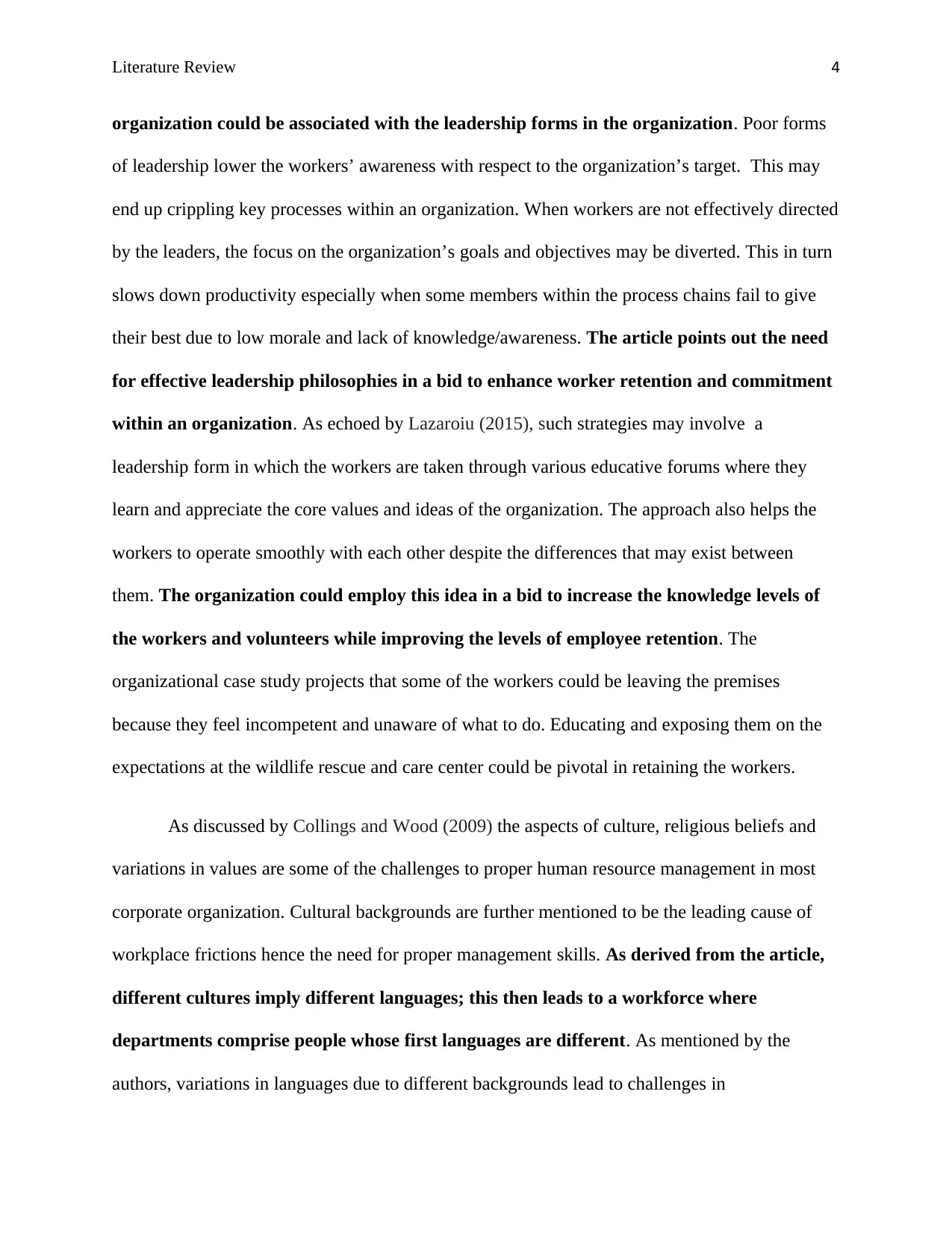
Literature Review 4
organization could be associated with the leadership forms in the organization. Poor forms
of leadership lower the workers’ awareness with respect to the organization’s target. This may
end up crippling key processes within an organization. When workers are not effectively directed
by the leaders, the focus on the organization’s goals and objectives may be diverted. This in turn
slows down productivity especially when some members within the process chains fail to give
their best due to low morale and lack of knowledge/awareness. The article points out the need
for effective leadership philosophies in a bid to enhance worker retention and commitment
within an organization. As echoed by Lazaroiu (2015), such strategies may involve a
leadership form in which the workers are taken through various educative forums where they
learn and appreciate the core values and ideas of the organization. The approach also helps the
workers to operate smoothly with each other despite the differences that may exist between
them. The organization could employ this idea in a bid to increase the knowledge levels of
the workers and volunteers while improving the levels of employee retention. The
organizational case study projects that some of the workers could be leaving the premises
because they feel incompetent and unaware of what to do. Educating and exposing them on the
expectations at the wildlife rescue and care center could be pivotal in retaining the workers.
As discussed by Collings and Wood (2009) the aspects of culture, religious beliefs and
variations in values are some of the challenges to proper human resource management in most
corporate organization. Cultural backgrounds are further mentioned to be the leading cause of
workplace frictions hence the need for proper management skills. As derived from the article,
different cultures imply different languages; this then leads to a workforce where
departments comprise people whose first languages are different. As mentioned by the
authors, variations in languages due to different backgrounds lead to challenges in
organization could be associated with the leadership forms in the organization. Poor forms
of leadership lower the workers’ awareness with respect to the organization’s target. This may
end up crippling key processes within an organization. When workers are not effectively directed
by the leaders, the focus on the organization’s goals and objectives may be diverted. This in turn
slows down productivity especially when some members within the process chains fail to give
their best due to low morale and lack of knowledge/awareness. The article points out the need
for effective leadership philosophies in a bid to enhance worker retention and commitment
within an organization. As echoed by Lazaroiu (2015), such strategies may involve a
leadership form in which the workers are taken through various educative forums where they
learn and appreciate the core values and ideas of the organization. The approach also helps the
workers to operate smoothly with each other despite the differences that may exist between
them. The organization could employ this idea in a bid to increase the knowledge levels of
the workers and volunteers while improving the levels of employee retention. The
organizational case study projects that some of the workers could be leaving the premises
because they feel incompetent and unaware of what to do. Educating and exposing them on the
expectations at the wildlife rescue and care center could be pivotal in retaining the workers.
As discussed by Collings and Wood (2009) the aspects of culture, religious beliefs and
variations in values are some of the challenges to proper human resource management in most
corporate organization. Cultural backgrounds are further mentioned to be the leading cause of
workplace frictions hence the need for proper management skills. As derived from the article,
different cultures imply different languages; this then leads to a workforce where
departments comprise people whose first languages are different. As mentioned by the
authors, variations in languages due to different backgrounds lead to challenges in
Paraphrase This Document
Need a fresh take? Get an instant paraphrase of this document with our AI Paraphraser
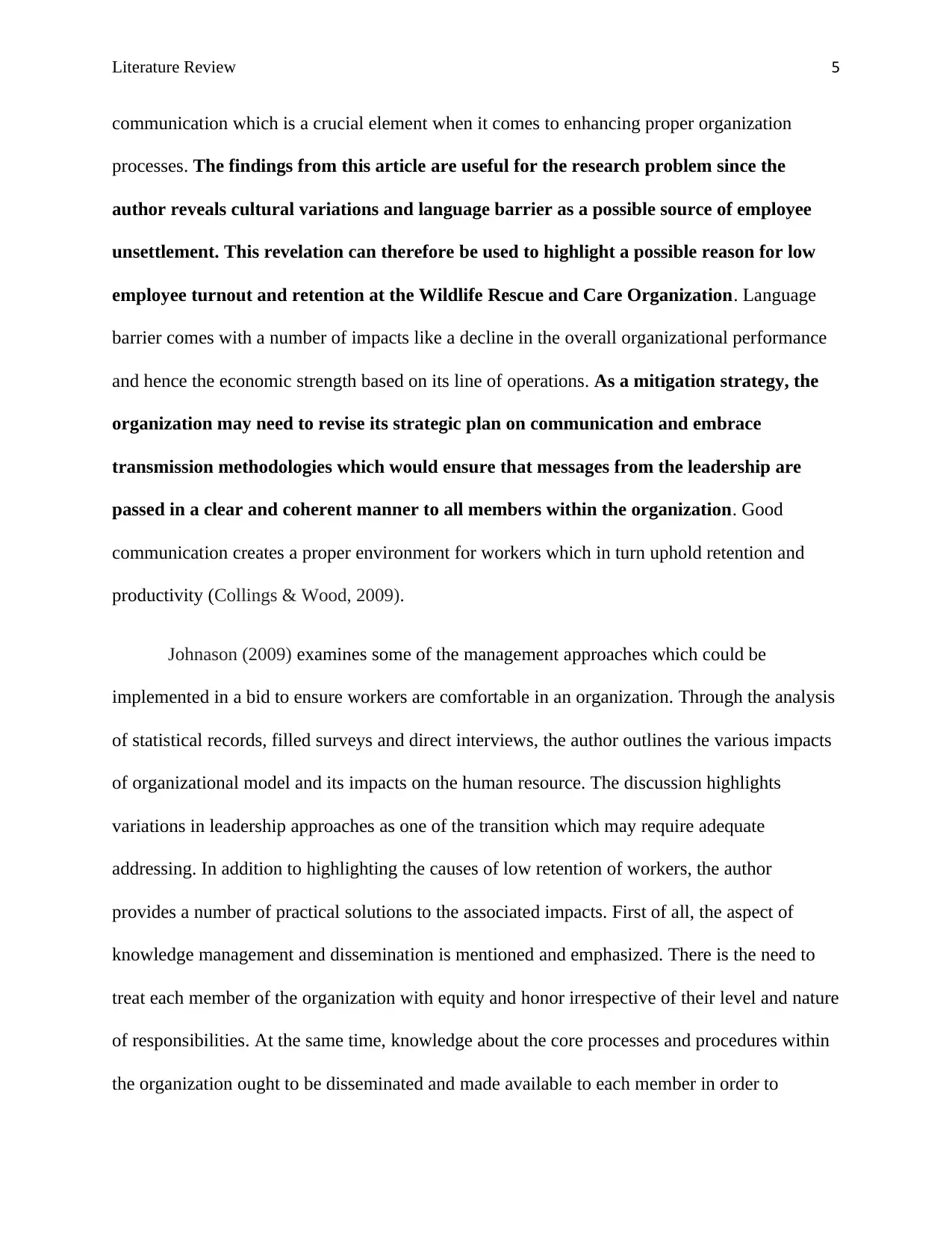
Literature Review 5
communication which is a crucial element when it comes to enhancing proper organization
processes. The findings from this article are useful for the research problem since the
author reveals cultural variations and language barrier as a possible source of employee
unsettlement. This revelation can therefore be used to highlight a possible reason for low
employee turnout and retention at the Wildlife Rescue and Care Organization. Language
barrier comes with a number of impacts like a decline in the overall organizational performance
and hence the economic strength based on its line of operations. As a mitigation strategy, the
organization may need to revise its strategic plan on communication and embrace
transmission methodologies which would ensure that messages from the leadership are
passed in a clear and coherent manner to all members within the organization. Good
communication creates a proper environment for workers which in turn uphold retention and
productivity (Collings & Wood, 2009).
Johnason (2009) examines some of the management approaches which could be
implemented in a bid to ensure workers are comfortable in an organization. Through the analysis
of statistical records, filled surveys and direct interviews, the author outlines the various impacts
of organizational model and its impacts on the human resource. The discussion highlights
variations in leadership approaches as one of the transition which may require adequate
addressing. In addition to highlighting the causes of low retention of workers, the author
provides a number of practical solutions to the associated impacts. First of all, the aspect of
knowledge management and dissemination is mentioned and emphasized. There is the need to
treat each member of the organization with equity and honor irrespective of their level and nature
of responsibilities. At the same time, knowledge about the core processes and procedures within
the organization ought to be disseminated and made available to each member in order to
communication which is a crucial element when it comes to enhancing proper organization
processes. The findings from this article are useful for the research problem since the
author reveals cultural variations and language barrier as a possible source of employee
unsettlement. This revelation can therefore be used to highlight a possible reason for low
employee turnout and retention at the Wildlife Rescue and Care Organization. Language
barrier comes with a number of impacts like a decline in the overall organizational performance
and hence the economic strength based on its line of operations. As a mitigation strategy, the
organization may need to revise its strategic plan on communication and embrace
transmission methodologies which would ensure that messages from the leadership are
passed in a clear and coherent manner to all members within the organization. Good
communication creates a proper environment for workers which in turn uphold retention and
productivity (Collings & Wood, 2009).
Johnason (2009) examines some of the management approaches which could be
implemented in a bid to ensure workers are comfortable in an organization. Through the analysis
of statistical records, filled surveys and direct interviews, the author outlines the various impacts
of organizational model and its impacts on the human resource. The discussion highlights
variations in leadership approaches as one of the transition which may require adequate
addressing. In addition to highlighting the causes of low retention of workers, the author
provides a number of practical solutions to the associated impacts. First of all, the aspect of
knowledge management and dissemination is mentioned and emphasized. There is the need to
treat each member of the organization with equity and honor irrespective of their level and nature
of responsibilities. At the same time, knowledge about the core processes and procedures within
the organization ought to be disseminated and made available to each member in order to
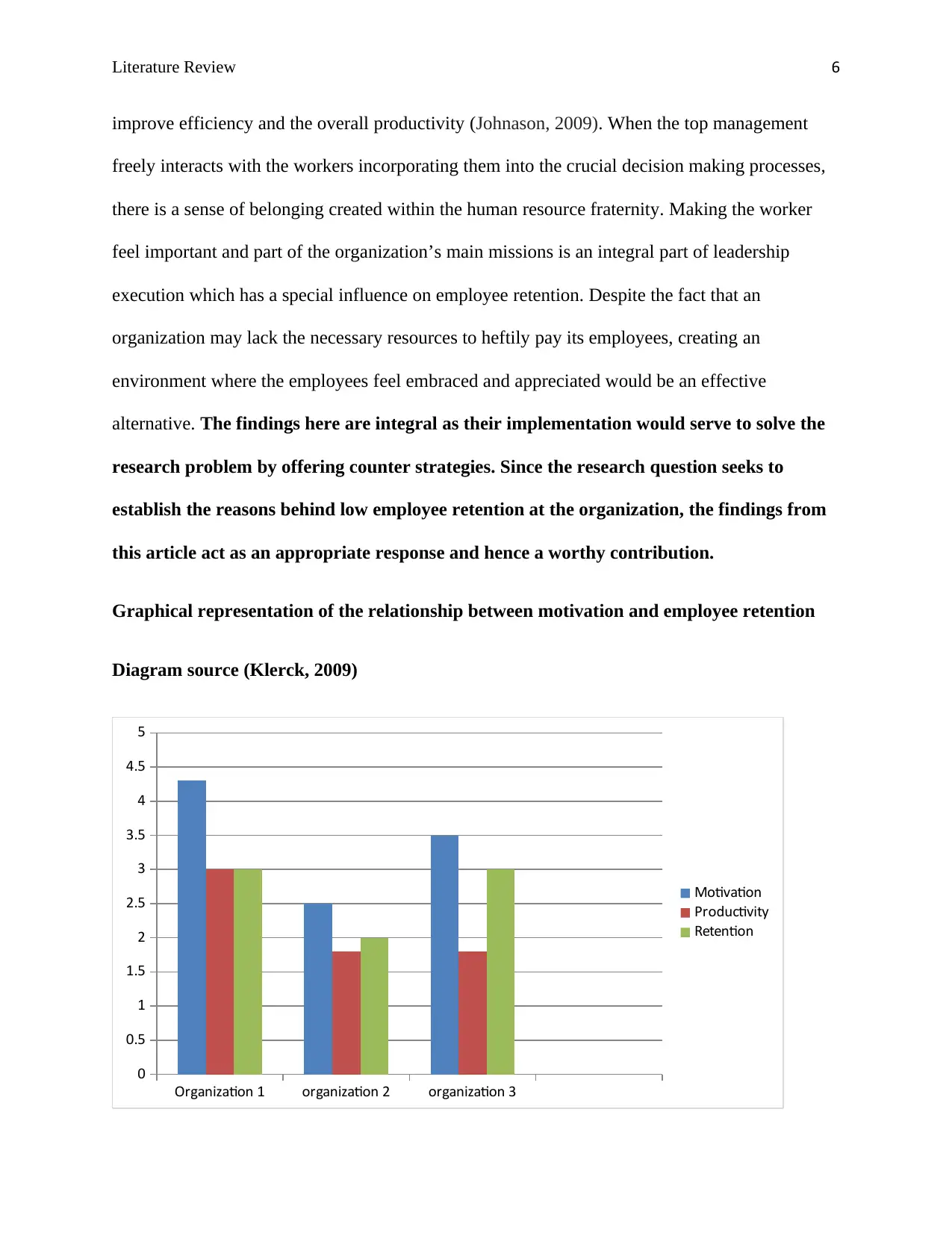
Literature Review 6
improve efficiency and the overall productivity (Johnason, 2009). When the top management
freely interacts with the workers incorporating them into the crucial decision making processes,
there is a sense of belonging created within the human resource fraternity. Making the worker
feel important and part of the organization’s main missions is an integral part of leadership
execution which has a special influence on employee retention. Despite the fact that an
organization may lack the necessary resources to heftily pay its employees, creating an
environment where the employees feel embraced and appreciated would be an effective
alternative. The findings here are integral as their implementation would serve to solve the
research problem by offering counter strategies. Since the research question seeks to
establish the reasons behind low employee retention at the organization, the findings from
this article act as an appropriate response and hence a worthy contribution.
Graphical representation of the relationship between motivation and employee retention
Diagram source (Klerck, 2009)
Organization 1 organization 2 organization 3
0
0.5
1
1.5
2
2.5
3
3.5
4
4.5
5
Motivation
Productivity
Retention
improve efficiency and the overall productivity (Johnason, 2009). When the top management
freely interacts with the workers incorporating them into the crucial decision making processes,
there is a sense of belonging created within the human resource fraternity. Making the worker
feel important and part of the organization’s main missions is an integral part of leadership
execution which has a special influence on employee retention. Despite the fact that an
organization may lack the necessary resources to heftily pay its employees, creating an
environment where the employees feel embraced and appreciated would be an effective
alternative. The findings here are integral as their implementation would serve to solve the
research problem by offering counter strategies. Since the research question seeks to
establish the reasons behind low employee retention at the organization, the findings from
this article act as an appropriate response and hence a worthy contribution.
Graphical representation of the relationship between motivation and employee retention
Diagram source (Klerck, 2009)
Organization 1 organization 2 organization 3
0
0.5
1
1.5
2
2.5
3
3.5
4
4.5
5
Motivation
Productivity
Retention
⊘ This is a preview!⊘
Do you want full access?
Subscribe today to unlock all pages.

Trusted by 1+ million students worldwide
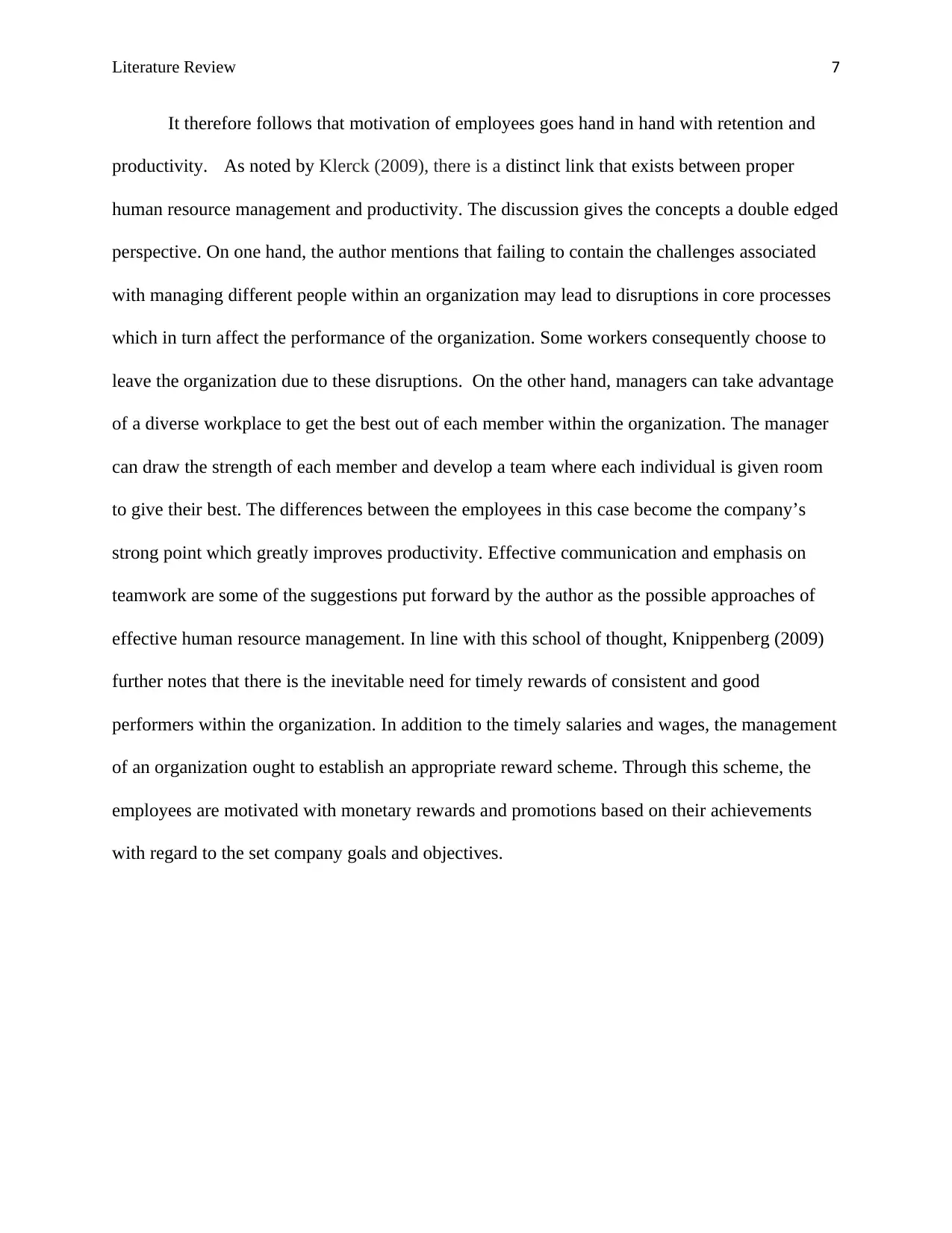
Literature Review 7
It therefore follows that motivation of employees goes hand in hand with retention and
productivity. As noted by Klerck (2009), there is a distinct link that exists between proper
human resource management and productivity. The discussion gives the concepts a double edged
perspective. On one hand, the author mentions that failing to contain the challenges associated
with managing different people within an organization may lead to disruptions in core processes
which in turn affect the performance of the organization. Some workers consequently choose to
leave the organization due to these disruptions. On the other hand, managers can take advantage
of a diverse workplace to get the best out of each member within the organization. The manager
can draw the strength of each member and develop a team where each individual is given room
to give their best. The differences between the employees in this case become the company’s
strong point which greatly improves productivity. Effective communication and emphasis on
teamwork are some of the suggestions put forward by the author as the possible approaches of
effective human resource management. In line with this school of thought, Knippenberg (2009)
further notes that there is the inevitable need for timely rewards of consistent and good
performers within the organization. In addition to the timely salaries and wages, the management
of an organization ought to establish an appropriate reward scheme. Through this scheme, the
employees are motivated with monetary rewards and promotions based on their achievements
with regard to the set company goals and objectives.
It therefore follows that motivation of employees goes hand in hand with retention and
productivity. As noted by Klerck (2009), there is a distinct link that exists between proper
human resource management and productivity. The discussion gives the concepts a double edged
perspective. On one hand, the author mentions that failing to contain the challenges associated
with managing different people within an organization may lead to disruptions in core processes
which in turn affect the performance of the organization. Some workers consequently choose to
leave the organization due to these disruptions. On the other hand, managers can take advantage
of a diverse workplace to get the best out of each member within the organization. The manager
can draw the strength of each member and develop a team where each individual is given room
to give their best. The differences between the employees in this case become the company’s
strong point which greatly improves productivity. Effective communication and emphasis on
teamwork are some of the suggestions put forward by the author as the possible approaches of
effective human resource management. In line with this school of thought, Knippenberg (2009)
further notes that there is the inevitable need for timely rewards of consistent and good
performers within the organization. In addition to the timely salaries and wages, the management
of an organization ought to establish an appropriate reward scheme. Through this scheme, the
employees are motivated with monetary rewards and promotions based on their achievements
with regard to the set company goals and objectives.
Paraphrase This Document
Need a fresh take? Get an instant paraphrase of this document with our AI Paraphraser
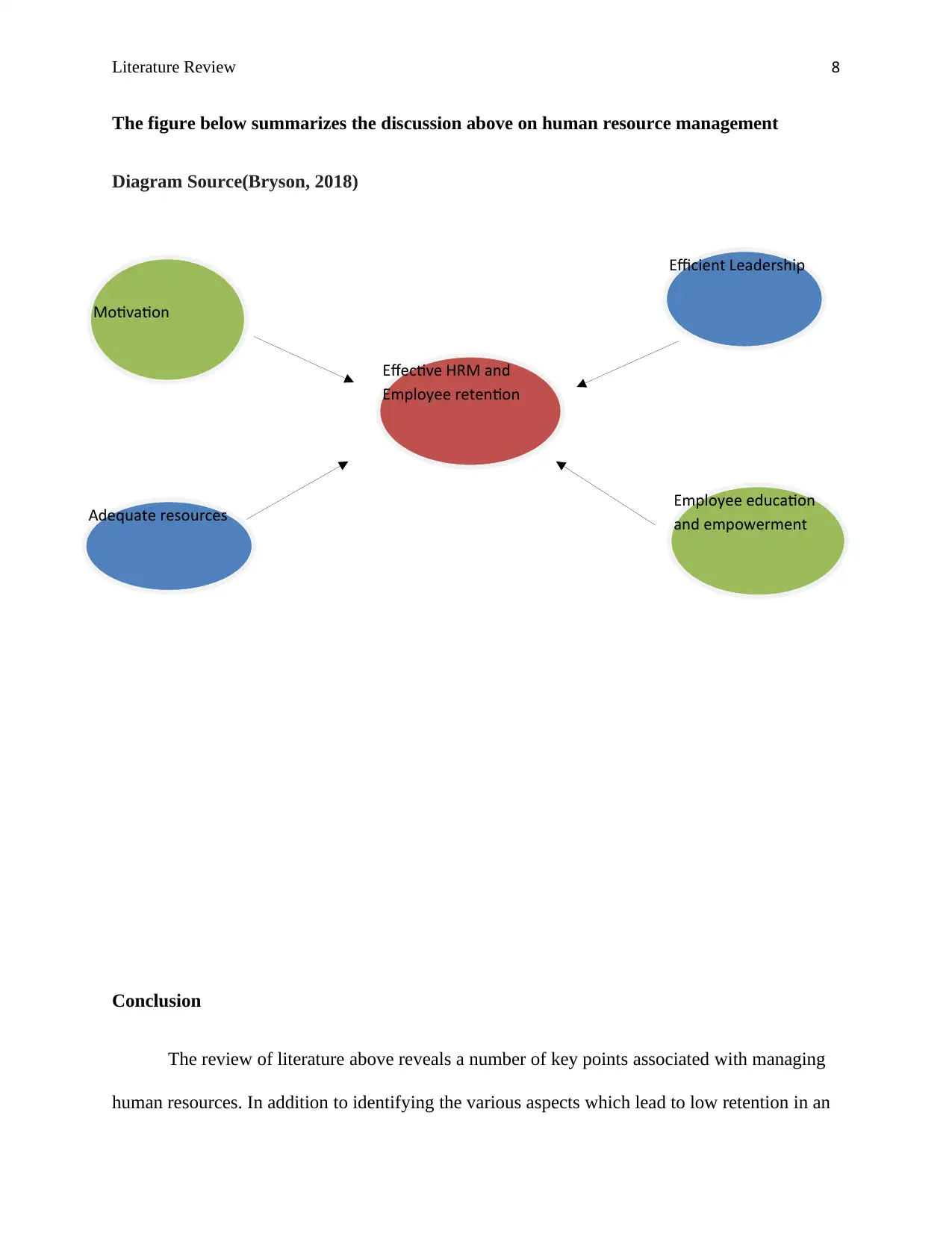
Literature Review 8
The figure below summarizes the discussion above on human resource management
Diagram Source(Bryson, 2018)
Conclusion
The review of literature above reveals a number of key points associated with managing
human resources. In addition to identifying the various aspects which lead to low retention in an
Effective HRM and
Employee retention
Motivation
Efficient Leadership
Adequate resources Employee education
and empowerment
The figure below summarizes the discussion above on human resource management
Diagram Source(Bryson, 2018)
Conclusion
The review of literature above reveals a number of key points associated with managing
human resources. In addition to identifying the various aspects which lead to low retention in an
Effective HRM and
Employee retention
Motivation
Efficient Leadership
Adequate resources Employee education
and empowerment
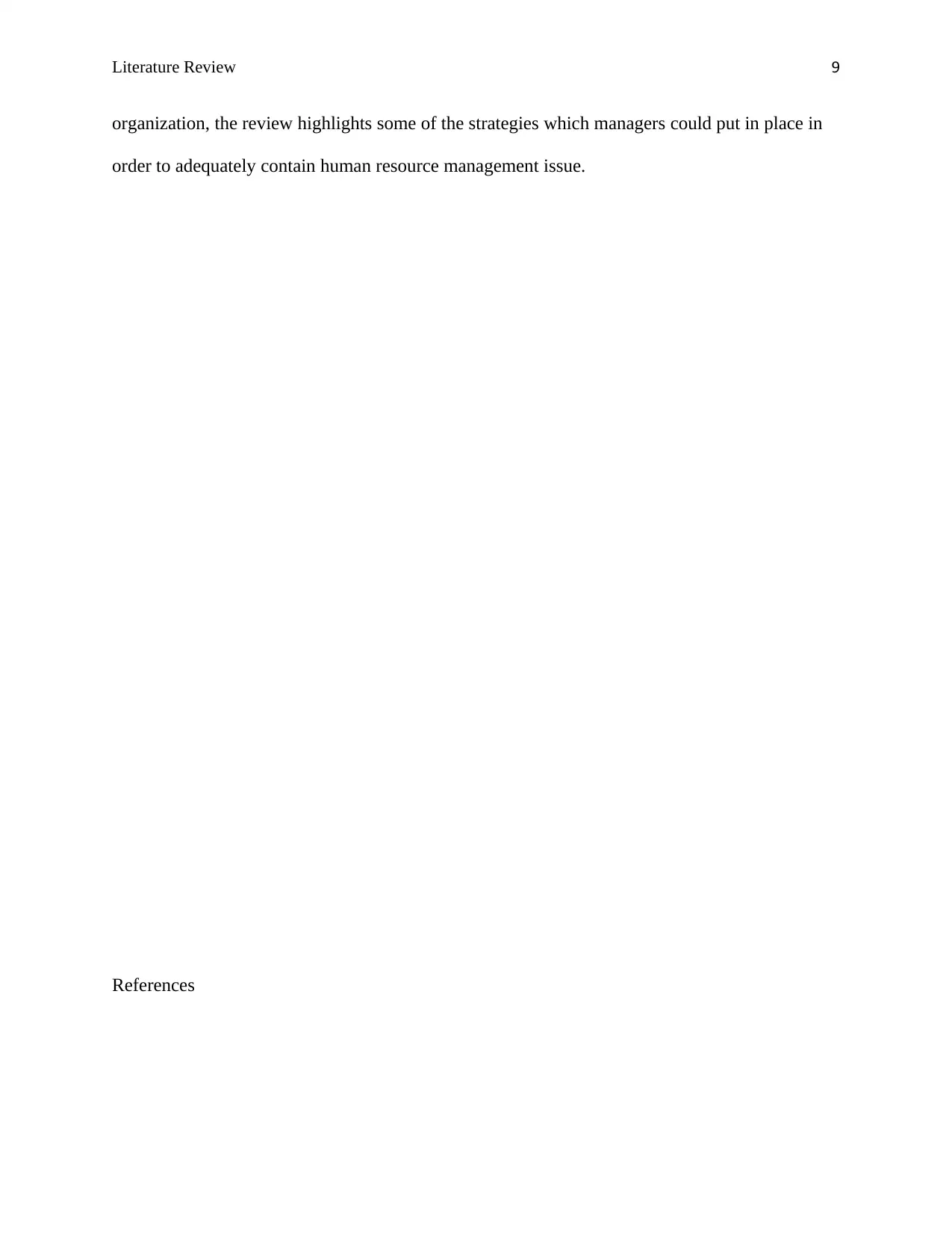
Literature Review 9
organization, the review highlights some of the strategies which managers could put in place in
order to adequately contain human resource management issue.
References
organization, the review highlights some of the strategies which managers could put in place in
order to adequately contain human resource management issue.
References
⊘ This is a preview!⊘
Do you want full access?
Subscribe today to unlock all pages.

Trusted by 1+ million students worldwide
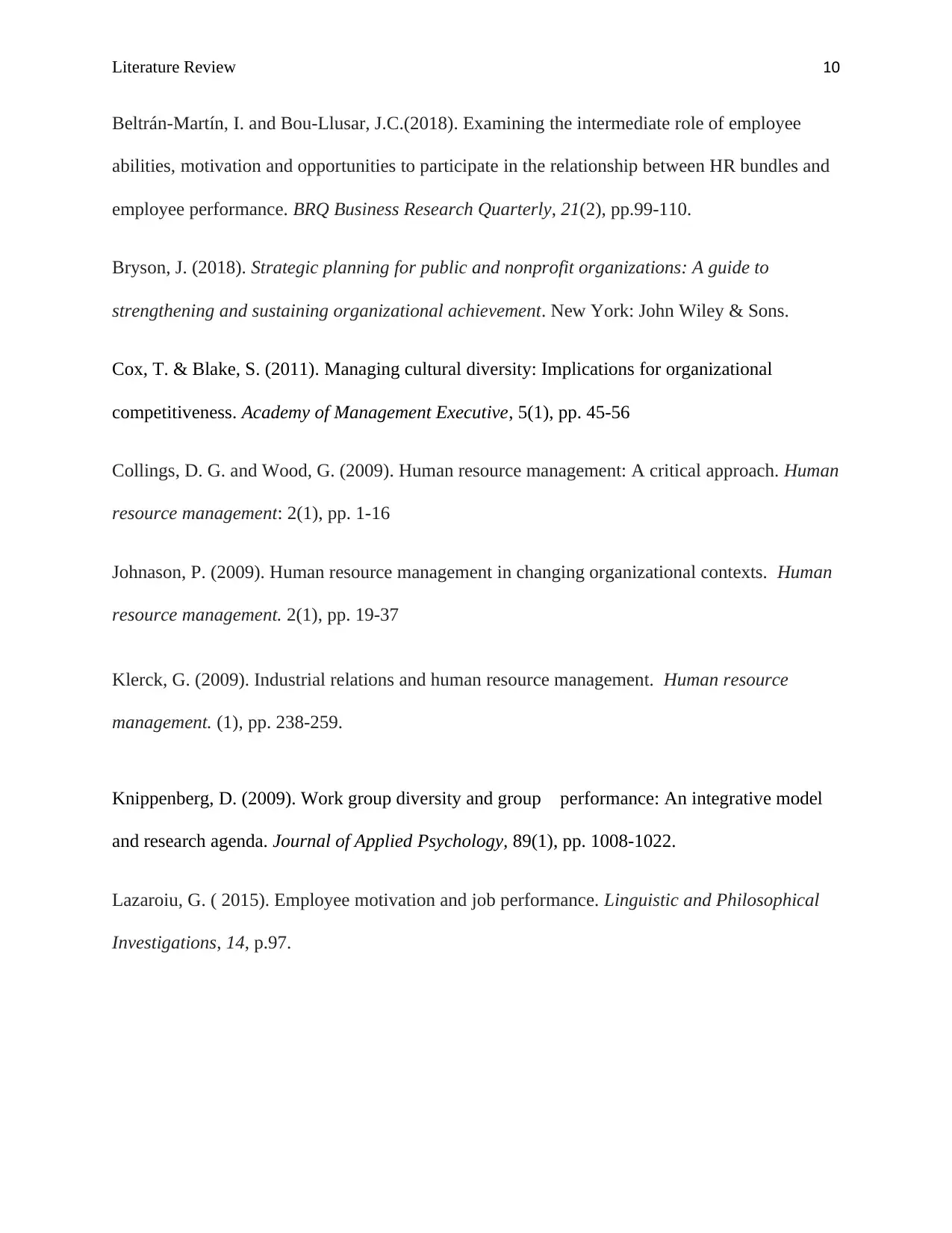
Literature Review 10
Beltrán-Martín, I. and Bou-Llusar, J.C.(2018). Examining the intermediate role of employee
abilities, motivation and opportunities to participate in the relationship between HR bundles and
employee performance. BRQ Business Research Quarterly, 21(2), pp.99-110.
Bryson, J. (2018). Strategic planning for public and nonprofit organizations: A guide to
strengthening and sustaining organizational achievement. New York: John Wiley & Sons.
Cox, T. & Blake, S. (2011). Managing cultural diversity: Implications for organizational
competitiveness. Academy of Management Executive, 5(1), pp. 45-56
Collings, D. G. and Wood, G. (2009). Human resource management: A critical approach. Human
resource management: 2(1), pp. 1-16
Johnason, P. (2009). Human resource management in changing organizational contexts. Human
resource management. 2(1), pp. 19-37
Klerck, G. (2009). Industrial relations and human resource management. Human resource
management. (1), pp. 238-259.
Knippenberg, D. (2009). Work group diversity and group performance: An integrative model
and research agenda. Journal of Applied Psychology, 89(1), pp. 1008-1022.
Lazaroiu, G. ( 2015). Employee motivation and job performance. Linguistic and Philosophical
Investigations, 14, p.97.
Beltrán-Martín, I. and Bou-Llusar, J.C.(2018). Examining the intermediate role of employee
abilities, motivation and opportunities to participate in the relationship between HR bundles and
employee performance. BRQ Business Research Quarterly, 21(2), pp.99-110.
Bryson, J. (2018). Strategic planning for public and nonprofit organizations: A guide to
strengthening and sustaining organizational achievement. New York: John Wiley & Sons.
Cox, T. & Blake, S. (2011). Managing cultural diversity: Implications for organizational
competitiveness. Academy of Management Executive, 5(1), pp. 45-56
Collings, D. G. and Wood, G. (2009). Human resource management: A critical approach. Human
resource management: 2(1), pp. 1-16
Johnason, P. (2009). Human resource management in changing organizational contexts. Human
resource management. 2(1), pp. 19-37
Klerck, G. (2009). Industrial relations and human resource management. Human resource
management. (1), pp. 238-259.
Knippenberg, D. (2009). Work group diversity and group performance: An integrative model
and research agenda. Journal of Applied Psychology, 89(1), pp. 1008-1022.
Lazaroiu, G. ( 2015). Employee motivation and job performance. Linguistic and Philosophical
Investigations, 14, p.97.
Paraphrase This Document
Need a fresh take? Get an instant paraphrase of this document with our AI Paraphraser

Literature Review 11
1 out of 11
Related Documents
Your All-in-One AI-Powered Toolkit for Academic Success.
+13062052269
info@desklib.com
Available 24*7 on WhatsApp / Email
![[object Object]](/_next/static/media/star-bottom.7253800d.svg)
Unlock your academic potential
Copyright © 2020–2025 A2Z Services. All Rights Reserved. Developed and managed by ZUCOL.





